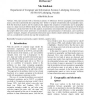Free Online Productivity Tools
i2Speak
i2Symbol
i2OCR
iTex2Img
iWeb2Print
iWeb2Shot
i2Type
iPdf2Split
iPdf2Merge
i2Bopomofo
i2Arabic
i2Style
i2Image
i2PDF
iLatex2Rtf
Sci2ools
INTERACT
2003
2003
Navigation in Hypermedia and Geographic Space, Same or Different?
: This paper presents both a theoretical analysis of differences between geographic and hypermedia spaces, and some experimental data comparing users’ ability to navigate in hypermedia and in geographic space. Both the theoretical analysis and the empirical data suggest that navigation in hypermedia and in geographic spaces to a large extent are different kinds of tasks. In the final section some possible consequences for the design of interactive systems that follow from this analysis are presented, most importantly that since it has been shown that people differ both in their preference for presentation and representation of information, and in preferred cognitive strategies, designers of hypermedia information spaces should consider additional means of supporting users as a complement to present day map-like navigation aids.
| Added | 31 Oct 2010 |
| Updated | 31 Oct 2010 |
| Type | Conference |
| Year | 2003 |
| Where | INTERACT |
| Authors | Nils Dahlbäck |
Comments (0)

